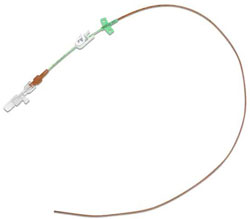PICC Insertion

A PICC line is a long hollow tube (often called a ‘line’) that is inserted via one of the veins of the upper arm. Once inserted the tip of the line sits in the large blood vessel just above the heart and the other end comes out of the upper arm and is fixed to the skin with a dressing on the top. It is this part left sticking out that can be accessed to administer intravenous therapy.
The main advantage of PICC lines over other CVADS is that they are relatively quick and straightforward to insert and remove. The main disadvantage is that part of the line is left sticking out of the upper arm. This needs to be dressed and kept dry whilst showering and precludes activities such as swimming. PICC lines also need to be flushed once a week when not in use (compared to once a month for a Port).
Not everyone’s veins are suitable for a PICC line.
The PICC insertion process usually takes about 30 minutes and takes place in an operating theatre or procedure room. An ultrasound examination of the veins will take place and then local anaesthetic is then given to numb the skin. This has a mild stinging effect for a few seconds only. A tiny (1-2mm) incision is made on the upper arm and the line inserted into the vein. The right or the left arm may be used depending on the vein scan and patient preference.
X-rays are taken in theatre to confirm that the PICC is in the correct position and then a dressing placed over the top of the external part of the line.
All patients will need to have MRSA swabs taken at least one week prior to the procedure (to allow time for processing). If you have started chemotherapy you will need to have blood tests taken 24-48 hours prior to the procedure, if not then blood tests taken within the last 8 weeks will normally suffice. Most blood thinning drugs e.g. Rivaroxaban, Warfarin, Apixaban, will need to be stopped. You will be advised how many days before you need to stop taking these medications if necessary.
On the day you may eat and drink normally up until the time of the procedure
Although sedation is not used it is still sensible to have someone available to collect you and drive you home afterwards.
You will be able to go home straight after the procedure is finished. There will be some mild tenderness over the upper arm. Simple painkillers e.g. paracetamol and/or ibuprofen will suffice.
It is inadvisable to engage in any vigorous activities involving the upper limbs e.g. golf, tennis. You must not immerse the PICC in water i.e. you must not go swimming or put the arm in the bath whilst the line is in your arm.
In order for the PICC to be kept in working condition it needs to be flushed by one of the chemotherapy nurses every week and the dressing must be changed once a week.
When the line needs to be removed it can simply be pulled out by one the chemotherapy nurses.
Mild tenderness is to be expected. However, moderate to severe pain perhaps with swelling or redness of surrounding skin could indicate an infection. If concerned please contact your chemotherapy centre in the first instance so that the insertion site can be assessed.
If you have a temperature or fever/chills at any point you should contact your chemotherapy centre immediately for assessment.
A thrombosis (blood clot) is a risk in anyone having chemotherapy – if you experience any swelling of, or pain in, the arms or head and neck you should seek medical attention immediately.
Having a PICC inserted is generally a very safe procedure. Use of modern imaging techniques (ultrasound and x-ray) has helped to reduce complications associated with this procedure but small risks still remain.
Damage to structures surrounding the vein can occur e.g. to nearby arteries, nerves. Infection can occur, either to the skin overlying the PICC or within the PICC itself. Sometimes this can be treated with antibiotics but occasionally the PICC will need to be removed.
Thrombosis means a blood clot in the vein and whilst this is a risk for anyone having chemotherapy, any sort of line in the vein likely increases this risk.
PICCs can move position over time and become blocked and unusable. If this was the case then the PICC might need to be repositioned or even removed and re-sited.
Further Questions
If you have any further questions about having a port inserted then please e-mail Dr Ben Gupta at enquiries@bristolvascularaccess.com or call Bristol Vascular Access on 07498 219558 (8-5pm).
Download this page as pdf

